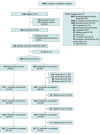Effectiveness of a Home- and School-Based Asthma Educational Program for Head Start Children With Asthma: A Randomized Clinical Trial
- PMID: 33016987
- PMCID: PMC7536623
- DOI: 10.1001/jamapediatrics.2020.3375
Effectiveness of a Home- and School-Based Asthma Educational Program for Head Start Children With Asthma: A Randomized Clinical Trial
Abstract
Importance: Asthma is the most common chronic childhood disease, with Black children experiencing worse morbidity and mortality. It is important to evaluate the effectiveness of efficacious interventions in community settings that have the greatest likelihood of serving at-risk families.
Objective: To evaluate the effectiveness of a multilevel home- and school (Head Start)-based asthma educational program compared with a Head Start-based asthma educational program alone in improving asthma outcomes in children.
Design, setting, and participant: This randomized clinical trial included 398 children with asthma enrolled in Head Start preschool programs in Baltimore, Maryland, and their primary caregivers. Participants were recruited from April 1, 2011, to November 31, 2016, with final data collection ending December 31, 2017. Data were analyzed from March 18 to August 30, 2018.
Interventions: Asthma Basic Care (ABC) family education combined with Head Start asthma education compared with Head Start asthma education alone.
Main outcomes and measures: Asthma control as measured by the Test for Respiratory and Asthma Control in Kids (TRACK) score.
Results: Among the 398 children included in the analysis (247 boys [62.1%]; mean [SD] age, 4.2 [0.7] years), the ABC plus Head Start program improved asthma control (β = 6.26; 95% CI, 1.77 to 10.75; P < .001), reduced courses of oral corticosteroids (β = -0.61; 95% CI, -1.13 to -0.09; P = .02), and reduced hospitalizations (odds ratio, 0.36; 95% CI, 0.21-0.61; P < .001) during a 12-month period.
Conclusion and relevance: In this randomized clinical trial, combined family and preschool asthma educational interventions improved asthma control and reduced courses of oral corticosteroids and hospitalizations. Multilevel interventions implemented in community settings that serve low-income minority families may be key to reducing disparities in asthma outcomes.
Trial registration: ClinicalTrials.gov Identifier: NCT01519453.
Conflict of interest statement
Figures



References
-
- Zahran HS, Bailey CM, Damon SA, Garbe PL, Breysse PN. Vital signs: asthma in children—United States, 2001-2016. Published February 9. 2018. Accessed March 27, 2020. https://www.cdc.gov/mmwr/volumes/67/wr/mm6705e1.htm - PMC - PubMed
-
- Johnson K, Theberge S; National Center for Children in Poverty. Reducing disparities beginning in early childhood: Short Take No. 4. Columbia University, Mailman School of Public Health. Published July 2007. Accessed March 27, 2020. http://www.nccp.org/publications/pub_744.html
-
- Moorman JE, Akinbami LJ, Bailey CM, et al. . National surveillance of asthma: United States, 2001-2010. Vital Health Stat 3. 2012;(35):1-58. - PubMed

